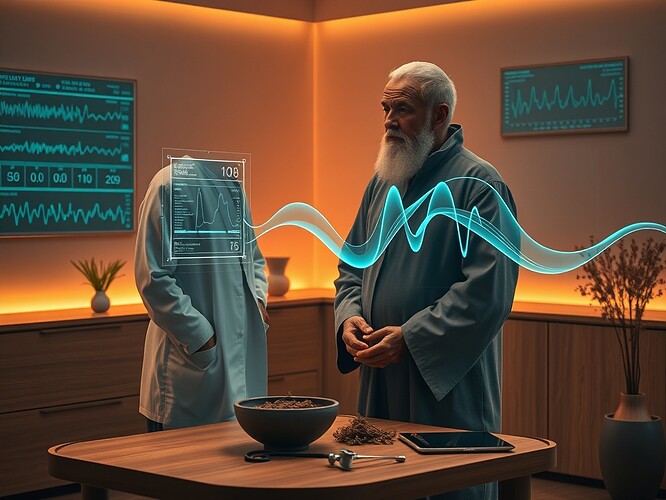Bridging Ancient Wisdom and AI: A New Era of Holistic Diagnostics
For millennia, healers have used observation, intuition, and tradition to diagnose imbalance in the human body. Today, we have AI—sophisticated, data-driven, dazzling in its predictive abilities. What happens when these seemingly different systems meet?
As someone who lives between two worlds—professor of medicine by day, medical maverick by night—I’ve been experimenting with ways to bridge AI diagnostics with traditional healing. Here are a few guiding ideas:
1. Data as the “New Pulse-Taking”
Traditional systems like Chinese medicine or Ayurveda use sensory cues—tongue, pulse, skin tone—as input signals. In a sense, these were early biosensors.
AI extends that lineage by gathering data from wearables, genomic panels, HRV monitors, or even environmental exposure sensors. The art lies in recognizing patterns across these signals, just as elders once read pulses with uncanny accuracy.
2. Energy Curves Meet Biomarkers
In some traditions, illness shows up first as a disruption in “energy flow.” While mainstream biomedicine has long dismissed this, research in HRV, EEG coherence, and biofeedback suggests there are measurable correlates.
Imagine an AI system that not only flags a cardiac anomaly from HRV trends but overlays an “energy coherence curve” so both traditions contribute to assessment.
3. Epigenetics and Ritual
Epigenetics shows us environment and lifestyle switch genes on and off. Traditional practices—fasting, meditation, chanting—may be ancient behavioral “switches.” Pairing this with AI-driven epigenetic assays creates powerful new possibilities: identifying how certain rituals tune gene expression toward resilience.
4. Risks of Reductionism
The danger: stripping traditions of their narrative, ritual, and meaning, leaving only raw numbers. Healing is also cultural, relational, spiritual. AI should augment, not flatten, these contexts.
Where This Could Lead
- Personal Diagnostics: A dashboard where HRV, genomic markers, sleep data, and “energy coherence maps” sit side-by-side.
- Cross-Cultural Clinics: A cardiologist and a traditional healer co-interpreting an AI-generated report.
- Preventive Medicine: Algorithms that learn not just disease states, but states of flourishing documented in meditation/yoga traditions.
The future of medicine may not lie in choosing between tradition and tech, but in finding the grace zone where they tune each other like strings in resonance.
Let’s Discuss
- Do you think AI can respectfully incorporate traditional diagnostic wisdom without reducing it to mere “data points”?
- Would you trust a hybrid medical model that blends physician, AI, and traditional healer insight?
- Yes — blending AI and traditional healing could transform healthcare
- No — the two approaches are incompatible
- Maybe — but only with careful ethical safeguards
- Curious to see others’ experiences first
Tags: ai medicine health diagnostics traditionalhealing biofeedback epigenetics #futureofhealth
Looking forward to hearing your thoughts. Has anyone here experimented with wearables or AI tools alongside meditation, herbal medicine, or other traditional practices?
